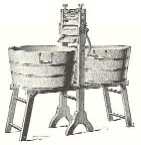Wash Days
This page was created May 25, 2004 Doing the laundry was by far one of the most time consuming of all the household chores, this task normally took up about 2 complete days to finish.
For years water was drawn from springs or wells and then this had to be heated either on the stove or over an open fire outside. Many times, this water was started prior to the family sitting down to breakfast so that it would be ready to use shortly after.
Dirt was extracted by rubbing the clothes over a washboard or boiling it in wash boilers. One can well imagine how this would have been an extremely hot chore in the summertime.
After thorough rinsing in clear water, the clothes were wrung by hand or if the women were lucky after a time, they had a wringer washer.
The laundry was then hung outside to dry whether it was summer or winter. Many women felt that the freezing of the clothes increased the whiteness as well as acting as a type of fabric softener and making the clothes easier to iron.
On rainy days, the wash was commonly hung in a room of the house to dry.
Washing Day One The procedure for wash day was arduous indeed. Water had to be carried in and heated as stated, and if you had "hard" water you could "break the water" with the addition of lye. As the water heated it would soften the water and bring a scum of minerals to the top to be removed before washing started.
Once the water was heated, white clothes were washed first so that any of the colored clothes wouldn't bleed on them. Also washed in the beginning of the process were the less dirty clothes. Men's work clothes were the last to be washed as they were always the dirtiest.
Now that the order has been described the actual procedure was a very repetitive and monotonous chore. It was actually done in several different steps for each of the categories of clothing.
Bringing in the water
Boiling of the clothes
Scrubbing them on the washboard
Emptying the wash water
Bringing in more water
Then with the rinsing of the clothes, the boiling process was repeated. As the water was heating an addition of blueing was added to the water in order to increase the whiteness. You had to be very careful with blueing as an incorrect amount or not properly dissolve amount could leave stains on the clothing. Blueing came in little balls wrapped in white material that a woman swished around the water until it was just the right shade of blue.
After the blueing the white clothes were then boiled again and rung out and hung on the clothesline.
I am assuming that since the blueing was used on the white clothes only, water was then required to be emptied, refilled and boiled for the rest of the clothing; so yet another step.
In addition to all of this, women carried the community pressure of not hanging a dingy wash out on the line. It was a matter of pride to have the whiteness load outside.
It is little wonder with the above chores being done on a weekly basis, you will never hear a pioneer woman being concerned with her weight. The did daily exercises long before it was popular.
Washing Day Two--Ironing After the clothes were dry on the line, the woman would bring in the clothes and sprinkle them with a small amount of water to soften them for the next day's ironing. The clothes were then tightly rolled and put in baskets overnight so that the moisture would penetrate them evenly. During the early days, most all items of laundry were ironed.
Ironing was a long hot job in the summertime but light colored or white cotton clothes didn't stay neat and nice looking unless they were starched and ironed.
One type of iron used was the above one called a sad iron. Many women felt that they were called this as that is how you felt when you were using them! The meaning of sad iron however, meant solid iron. These were heated on top of the kitchen stove, some of them came in one piece and some were made with removable handles. Two or three irons were used to ensure there being a hot iron ready when needed. The removable handle was then taken from the iron being used and clipped on to the one on the stove and you were ready to go.
Most women in the early days made their own starch. Almost all of the fancy clothes were starched as were the pillow cases,tablecloths and napkins. The starch was made by putting a little bit of flour in a pan and then adding enough water to make it soft and then "just" enough more water to create a liquid, yet not make it thin.
Then you added boiling water to it until you reached the concentration you wanted. And the water had to be boiling for this. If you were a good starch maker there would be no lumps in it and you wouldn't have to strain it.
During some periods in the rural areas lessons were given through the extension agencies on how to iron shirts in the shortest time possible. It was considered a skill to be able to iron a shirt using very few irons. Four irons were standard for a man's white shirt while some women could do it with three by ironing faster!
I find it comes as little surprise that when electricity reached some homes one of their first purchases was an iron falling to a second purchase only to a washing machine (wringer type).
Memories Home Website Coordinator

